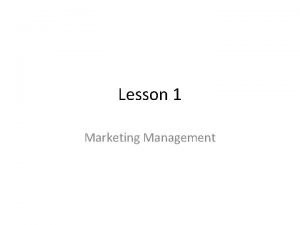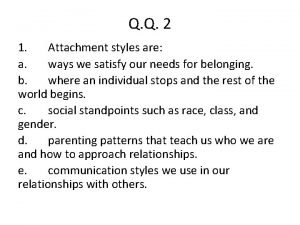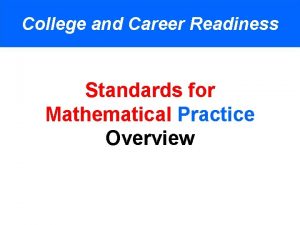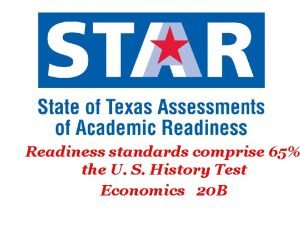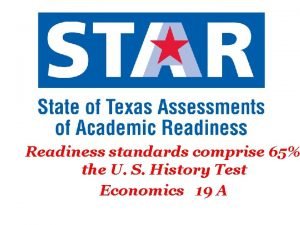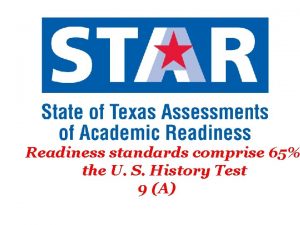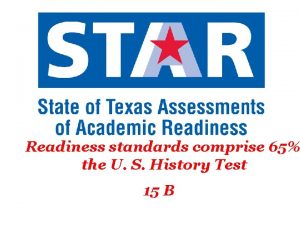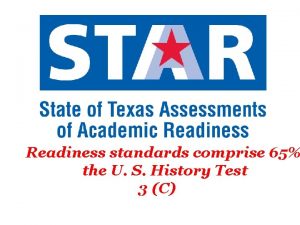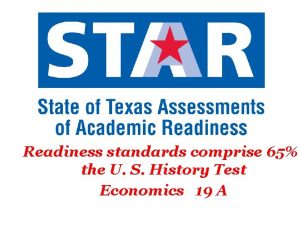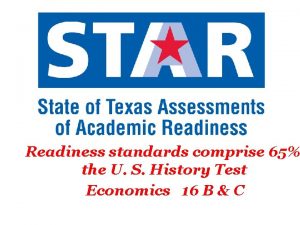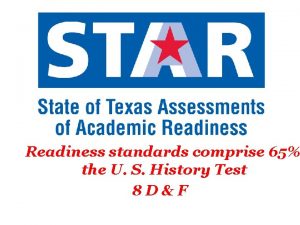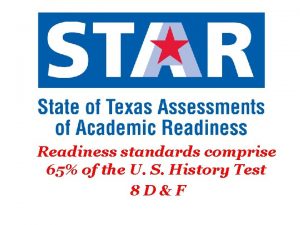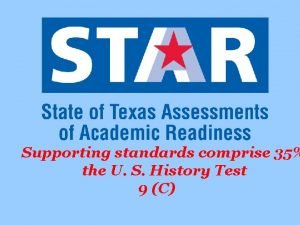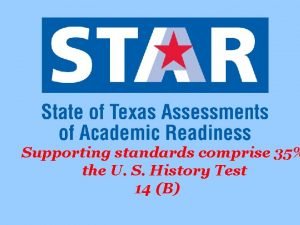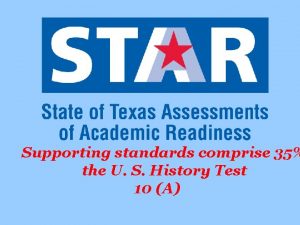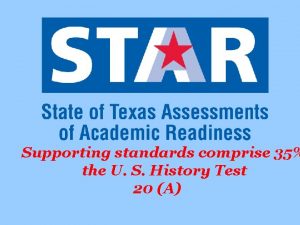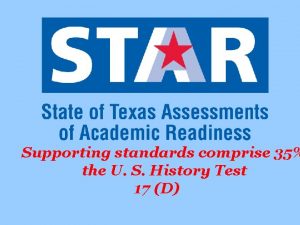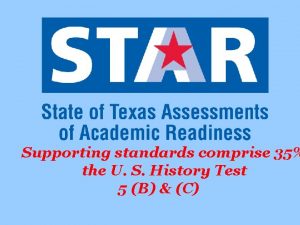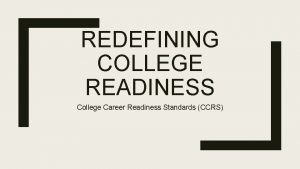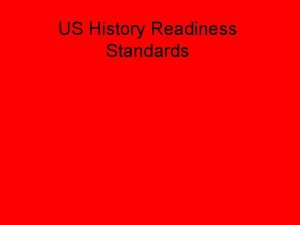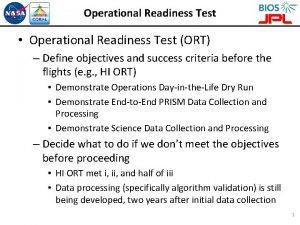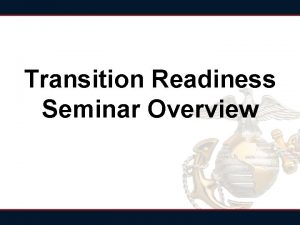Readiness standards comprise 65 the U S History









































- Slides: 41

Readiness standards comprise 65% the U. S. History Test 8 B&E

Readiness Standard (8) The student understands the impact of significant national & international decisions & conflicts in the Co War on the United States. The Student is expected to: (B) Describe how Cold War tensions w intensified by the arms race, the spa race, Mc. Carthyism, & the House Un American Activities Committee (HUA the findings of which were confirmed the Venona Papers

Readiness Standard (8) The student understands the impact of significant national & international decisions & conflicts in the Co War on the United States. The Student is expected to: (B) 1 Describe how Cold War tension were intensified by the arms race (19 1991)

The Cold War Arms Race--Background • The first nuclear weapon was created by U. S. during the World War II & was developed to be used against the Axis powers. • A ring of spies operating within the Manhattan Project, (including Klaus Fuchs & Theodore Hall) had kept Stalin well informed of American progress They provided the Soviets with detailed designs of the implosion bomb and the hydrogen bomb. • Fuchs’ arrest in 1950 led to the arrests of many other Russian spies, including Harry Gold, David Greenglass, and Ethel and Julius Rosenberg. • In the years immediately after the Second World War, the United States had a monopoly on specific knowledge of and raw materials for nuclear weaponry. American leaders hoped that their exclusive ownership of nuclear weapons would be enough to draw concessions from the Soviet Union but this proved ineffective.

The Cold War Arms Race • Behind the scenes, the Soviet government was working on building its own atomic weapons. While American experts had predicted that the Soviet Union would not have nuclear weapons until the mid-1950 s, the first Soviet bomb was detonated on August 29, 1949, shocking the entire world. • Both governments spent massive amounts to increase the quality and quantity of their nuclear arsenals. Both nations quickly began the development of a hydrogen bomb and the United States detonated the first hydrogen bomb on November 1, 1952. • Again, the Soviets surprised the world by exploding a deployable thermonuclear device in August 1953 although it was not a true multi-stage hydrogen bomb. However, it was small enough to be dropped from an airplane, making it ready for use. The development of these two Soviet bombs was greatly aided by the Russian spies Harry Gold and Klaus Fuchs.

The Cold War Arms Race • The most important development in terms of delivery in the 1950 s was the introduction of intercontinental ballistic missiles, ICBMs. Missiles had long been regarded the ideal platform for nuclear weapons, and were potentially a more effective delivery system than strategic bombers, which was the primary delivery method at the beginning of the Cold War. • On October 4, 1957, the Soviet Union showed the world that they had missiles able to reach any part of the world when they launched the Sputnik satellite into Earth orbit. The United States launched its own satellite on the October 31, 1959. The Space Race showcased technology critical to the delivery of nuclear weapons, the ICBM boosters, while maintaining the appearance of being for science and exploration.

The Cold War Arms Race • This policy was part of what became known as Mutual Assured Destruction: both sides knew that any attack upon the other would be devastating to themselves, thus in theory restraining them from attacking the other. • In addition to the United States and the Soviet Union, three other nations, the United Kingdom (1952), People’s Republic of China (1964), & France (1960) also developed far smaller nuclear stockpiles. • The Cuban Missile Crisis brought the world to the very brink of annihilation. That sober realization no doubt contributed to the more balanced & rational diplomacy that distinguished Soviet-American foreign policy in the years that followed 1962.

The Cold War Arms Race • During the mid-1980 s, the U. S-Soviet relations significantly improved. Mikhail Gorbachev assumed control of the Soviet Union after the deaths of several former Soviet leaders, and announced a new era of perestroika and glasnost, meaning restructuring and openness respectively. • Much of the Soviet Union began to declare independence and slowly became free of Soviet influence. One of the most iconic events of the collapse of the Soviet Union was the destruction of the Berlin Wall on November 10, 1989. • On December 8, 1991, the Soviet Union dissolved and the Commonwealth of Independent States (CIS) was established. This event marked the end of the 50 - year-long Cold War.

Readiness Standard (8) The student understands the impact of significant national & international decisions & conflicts in the Co War on the United States. The Student is expected to: (B) 2 Describe how Cold War tensio were intensified by the space race

The Space Race • The Space Race was a 20 th-century (1955 -1972) competition between two Cold War rivals, the Soviet Union (USSR) and U. S. , for supremacy in spaceflight capability. • The technological superiority required for such supremacy was seen as necessary for national security, and symbolic of ideological superiority. The Space Race spawned pioneering efforts to launch artificial satellites, unmanned probes of the Moon, Venus, & Mars, & human spaceflight in low Earth orbit & and to the Moon. • The Soviets won the first “lap” with the October 4, 1957 launch of Sputnik 1.

The Space Race The United States’ Apollo 11 was “One small step for man. . . onefirst giant leap for the manned mission to land on mankind. ” the Moon, on July 20, 1969 • There have been six manned U. S. landings (between 1969 and 1972) and numerous unmanned landings, with no soft landings happening from 1976 until December 14, 2013. • A total of twelve men have landed on the Moon. This was accomplished with two US pilot-astronauts flying a Lunar Module on each of six NASA missions across a 41 -month time span starting on July 20, 1969 UTC, with Neil Armstrong & Buzz Aldrin on Apollo 11, and ending on 14 December 1972 UTC with Gene Cernan & Jack Schmitt on Apollo 17. Cernan was the last to step off the lunar surface.


Readiness Standard (8) The student understands the impact of significant national & international decisions & conflicts in the Co War on the United States. The Student is expected to: (B) 3 Describe how Cold War tensio were intensified by Mc. Carthyism

The “Red Scare” & Mc. Carthyism • A national anxiety about communism abroad and 5 th column infiltration at home • The Soviets gained atomic power in 1949 • The Rise of Joe Mc. Carthy and His Four and a Half Year Crusade

Mc. Carthyism • Mc. Carthyism is the practice of making accusations of disloyalty, subversion, or treason without proper regard for evidence. It also means “the practice of making unfair allegations or using unfair investigative techniques, especially in order to restrict dissent or political criticism. ” • The term has its origins in the period in the United States known as the Second Red Scare, lasting roughly from 1950 to 1956 and characterized by heightened fears of communist influence on American institutions & espionage by Soviet agents. • Originally coined to criticize the anti-communist pursuits of Republican U. S. Senator Joseph Mc. Carthy of Wisconsin, “Mc. Carthyism” soon took on a broader meaning, describing the excesses of similar efforts. The term is also now used more generally to describe reckless, unsubstantiated accusations, as well as demagogic attacks on the character or patriotism of political adversaries.

Mc. Carthyism • During the Mc. Carthy era, thousands of Americans were accused of being communists or communist sympathizers and became the subject of aggressive investigations and questioning before government or private-industry panels, committees and agencies. • The primary targets of such suspicions were government employees, those in the entertainment industry, educators and union activists. Suspicions were often given credence despite inconclusive or questionable evidence, and the level of threat posed by a person’s real or supposed leftist associations or beliefs was often greatly exaggerated.

Mc. Carthyism • Many people suffered loss of employment and/or destruction of their careers; some even suffered imprisonment. Most of these punishments came about through trial verdicts later overturned, laws that would be declared unconstitutional, dismissals for reasons later declared illegal or actionable or extra-legal procedures that would come into general disrepute. • The most famous examples of Mc. Carthyism include the speeches, investigations, and hearings of Senator Mc. Carthy himself; the Hollywood blacklist, , associated with hearings conducted by the House Un-American Activities Committee (HUAC); and the various anti-communist activities of the Federal Bureau of Investigation (FBI) under Director J. Edgar Hoover.

Readiness Standard (8) The student understands the impact of significant national & international decisions & conflicts in the Co War on the United States. The Student is expected to: (B) 4 Describe how Cold War tensio were intensified by the House Un. American Activities Committee (HUA

House Un-American Activities Committee • The House Committee on Un-American Activities (HUAC) was an investigative committee of the U. S. House of Representatives. It was created in 1938 to investigate alleged disloyalty and subversive activities on the part of private citizens, public employees, and those organizations suspected of having Communist ties. • The House Committee on Un-American Activities became a standing (permanent) committee in 1945. Under the mandate of Public Law 601, passed by the 79 th Congress the committee of nine representatives investigated suspected threats of subversion or propaganda that attacked “the form of government guaranteed by our Constitution. ”

House Un-American Activities Committee • Under this mandate, the committee focused its investigations on real and suspected communists in positions of actual or supposed influence in the United States society. A significant step for HUAC was its investigation of the charges of espionage brought against Alger Hiss in 1948. This investigation ultimately resulted in Hiss’s trial and conviction for perjury, and convinced many of the usefulness of congressional committees for uncovering communist subversion.

House Un-American Activities Committee • In 1947, the committee held nine days of hearings into alleged communist propaganda and influence in the Hollywood motion picture industry. After conviction on contempt of Congress charges for refusal to answer some questions posed by committee members, the “Hollywood Ten” were blacklisted by the industry. Eventually, more than 300 artists—including directors, radio commentators, actors and particularly screenwriters—were boycotted by the studios. • Made U. S. government the object of suspicion in the eyes of the world; it appeared it was trying to combat totalitarian methods by totalitarian means • In the wake of the downfall of Senator Mc. Carthy (who never served in the House, nor HUAC), the prestige of HUAC began a gradual decline beginning in the late 1950 s. By 1959, the committee was being denounced by former President Truman as the “most un-American thing in the country today. ”

Readiness Standard (8) The student understands the impact of significant national & international decisions & conflicts in the Co War on the United States. The Student is expected to: (B) 5 Describe how Cold War tension were intensified by the findings of wh were confirmed by the Venona Pape

The Venona Papers • The Venona project was a counter-intelligence program initiated by the United States Army Signal Intelligence Service that lasted from 1943 to 1980. The program attempted to decrypt messages sent by Soviet Union intelligence agencies, including its foreign intelligence service and military intelligence services. • During the program's four decades, approximately 3, 000 messages were at least partially decrypted and translated. The project produced some of the most important breakthroughs for western counter-intelligence in this period, including the discovery of the Cambridge spy ring and the exposure of Soviet espionage targeting the Manhattan Project. • The project was one of the most sensitive secrets of United States intelligence. It remained secret for over a decade after it ended and was not officially declassified until 1995.

The Venona Papers Julius and Ethel Rosenberg • Venona has added significant information to the case of Julius and Ethel Rosenberg, making it clear Julius was guilty of espionage, but also showing that Ethel was probably no more than an accomplice, if that. Venona and other recent information has shown, while the content of Julius’ atomic espionage was not as vital as alleged at the time of his espionage activities, in other fields it was extensive.

Readiness Standard (8) The student understands the impact of significant national & international decisions & conflicts in the Co War on the United States. The Student is expected to: (E) Analyze the major issues & event the Vietnam War such as the Tet Offen the escalation of forces, Vietnamizatio the fall of Saigon

Readiness Standard (8) The student understands the impact of significant national & international decisions & conflicts in the Co War on the United States. The Student is expected to: (E) 1 Analyze the major issues & even the Vietnam War such as the Tet Offen

Tet Offensive—Jan. 30 -Feb. 25, 1968 • The Tet Offensive was one of the largest military campaigns of the Vietnam War, launched on January 30, 1968 by forces of the Viet Cong and North Vietnamese Army against South Vietnam, the U. S. , & their allies. It was a campaign of surprise attacks against military & civilian commands and control centers throughout South Vietnam. • The operations are referred to as the Tet Offensive because there was a prior agreement to “cease fire” during the Tet Lunar New Year celebrations. Both North and South Vietnam announced on national radio broadcasts that there would be a two-day cease-fire during the holiday.

Tet Offensive—Jan. 30 -Feb. 25, 1968 • The initial attacks stunned the US and South Vietnamese armies and caused them to temporarily lose control of several cities, but they quickly regrouped to beat back the attacks, inflicting massive casualties on Communist forces. • Although the offensive was a military defeat for the Communists, it had a profound effect on the US government and shocked the U. S. public, which had been led to believe by its political and military leaders that the Communists were, due to previous defeats, incapable of launching such a massive effort.

Tet Offensive—Jan. 30 -Feb. 25, 1968 • Although the Tet Offensive was a significant victory for allied forces, in terms of casualties and control of territory, it was a sound defeat when evaluated from the point of view of strategic consequences: it became a turning point in America's involvement in the Vietnam War because it had a profound impact on domestic support for the conflict. Despite the military failure for the Communist forces, the Tet Offensive became a political victory for them and ended the career of president Lyndon B. Johnson, who declined to run for re-election as his approval rating slumped from 48 to 36 percent.

Readiness Standard (8) The student understands the impact of significant national & international decisions & conflicts in the Co War on the United States. The Student is expected to: (E) 2 Analyze the major issues & even the Vietnam War such as the escalatio forces

Escalation— Background • It was David vs. Goliath, with U. S. playing Goliath. • On August 2, 1964, gunboats of North Vietnam allegedly fired on ships of the United States Navy stationed in the GULF OF TONKIN. They had been sailing 10 miles off the coast of North Vietnam in support of the South Vietnamese navy. • When reports that further firing occurred on August 4, President Johnson quickly asked Congress to respond. With nearly unanimous consent, members of the Senate and House empowered Johnson to “take all necessary measures” to repel North Vietnamese aggression. The Tonkin Gulf Resolution gave the President a “BLANK CHECK” to wage the war in Vietnam as he saw fit. After Lyndon Johnson was elected President in his own right that November, he chose escalate the conflict.

Escalation— 1965 -68 • Emboldened by the Gulf of Tonkin Resolution, in February 1965, the United States began a long program of sustained bombing of North Vietnamese targets known as OPERATION ROLLING THUNDER. At first only military targets were hit, but as months turned into years, civilian targets were pummeled as well. • The United States also bombed the Ho Chi Minh Trail, a supply line used by the North Vietnamese to aid the VIETCONG. The trail meandered through Laos and Cambodia, so the bombing was kept secret from the Congress and the American people. More bombs rained down on Vietnam than the Allies used on the Axis powers during the whole of World War II.

Escalation— 1965 -68 • Additional sorties delivered defoliating agents such as AGENT ORANGE and napalm to remove the jungle cover utilized by the Vietcong. The intense bombardment did little to deter the communists. They continued to use the Ho Chi Minh trail despite the grave risk. The burrowed underground, building 30, 000 miles of tunnel networks to keep supply lines open. • By the end of 1965, there were 189, 000 American troops stationed in Vietnam. At the end of the following year, that number doubled. Casualty reports steadily increased. Unlike World War II, there were few major ground battles. • Most Vietnamese attacks were by ambush or night skirmishes. Many Americans died by stepping on landmines or by triggering BOOBY TRAPS. Although Vietnamese body counts were higher, Americans were dying at rate of approximately 100 per week through 1967. By the end of that year there were nearly 500, 000 American combat troops stationed in Vietnam.

Readiness Standard (8) The student understands the impact of significant national & international decisions & conflicts in the Co War on the United States. The Student is expected to: (E) 3 Analyze the major issues & even the Vietnam War such as Vietnamiza

Vietnamization • Severe communist losses during the Tet Offensive allowed U. S. President Nixon to begin troop withdrawals. His plan, called the Nixon Doctrine, was to build up the Army of the Republic of Vietnam (ARVN), so that they could take over the defense of South Vietnam. • The policy became known as “Vietnamization. ” The new approach had much in common with the policies of the Kennedy administration. One important difference, however, remained. While Kennedy insisted that the South Vietnamese fight the war themselves, he attempted to limit the scope of the conflict. • Vietnamization was a policy of the President Nixon administration during the Vietnam War to end the U. S. ’ involvement in the war and “expand, equip, and train South Vietnam’s forces and assign to them an ever-increasing combat role, at the same time steadily reducing the number of U. S. combat troops. ” The new policy did not, however, reject combat by the U. S. Air Force.


Readiness Standard (8) The student understands the impact of significant national & international decisions & conflicts in the Co War on the United States. The Student is expected to: (E) 4 Analyze the major issues & events of the Vie War such as the fall of Saigon

Fall of Saigon • The Fall of Saigon was the capture of Saigon, the capital of South Vietnam, by the People’s Army of Vietnam & the National Liberation Front of South Vietnam (aka Viet Cong) on April 30, 1975. The event marked the end of the Vietnam War & the start of a transition period leading to the formal reunification of Vietnam into a Socialist Republic governed by the Communist Party. • The fall of the city was preceded by the evacuation of almost all the American civilian and military personnel in Saigon, along with tens of thousands of South Vietnamese civilians associated with the southern regime. The evacuation culminated in Operation Frequent Wind, the largest helicopter evacuationrefugees in history. South Vietnamese arrive on a U. S. Navy vessel during Operation Frequent Wind.

Fall of Saigon A North Vietnamese tank rolls through the gate of the Presidential Palace in Saigon, signifying the fall of South Vietnam. Smoke rises from the southwestern part of Saigon on May 7, 1968 as residents stream across a bridge leaving the capital to escape heavy fighting between the Viet Cong and South Vietnamese soldiers. (AP Photo)


Fini
 What comprise a community
What comprise a community Marketing management
Marketing management You are a very smart girl tammy tells her daughter
You are a very smart girl tammy tells her daughter Tied synoynm
Tied synoynm College and career readiness standards math
College and career readiness standards math Factors necessary for service standards are
Factors necessary for service standards are Hát kết hợp bộ gõ cơ thể
Hát kết hợp bộ gõ cơ thể Slidetodoc
Slidetodoc Bổ thể
Bổ thể Tỉ lệ cơ thể trẻ em
Tỉ lệ cơ thể trẻ em Chó sói
Chó sói Thang điểm glasgow
Thang điểm glasgow Bài hát chúa yêu trần thế alleluia
Bài hát chúa yêu trần thế alleluia Kể tên các môn thể thao
Kể tên các môn thể thao Thế nào là hệ số cao nhất
Thế nào là hệ số cao nhất Các châu lục và đại dương trên thế giới
Các châu lục và đại dương trên thế giới Công của trọng lực
Công của trọng lực Trời xanh đây là của chúng ta thể thơ
Trời xanh đây là của chúng ta thể thơ Mật thư tọa độ 5x5
Mật thư tọa độ 5x5 101012 bằng
101012 bằng độ dài liên kết
độ dài liên kết Các châu lục và đại dương trên thế giới
Các châu lục và đại dương trên thế giới Thể thơ truyền thống
Thể thơ truyền thống Quá trình desamine hóa có thể tạo ra
Quá trình desamine hóa có thể tạo ra Một số thể thơ truyền thống
Một số thể thơ truyền thống Cái miệng nó xinh thế
Cái miệng nó xinh thế Vẽ hình chiếu vuông góc của vật thể sau
Vẽ hình chiếu vuông góc của vật thể sau Nguyên nhân của sự mỏi cơ sinh 8
Nguyên nhân của sự mỏi cơ sinh 8 đặc điểm cơ thể của người tối cổ
đặc điểm cơ thể của người tối cổ Giọng cùng tên là
Giọng cùng tên là Vẽ hình chiếu đứng bằng cạnh của vật thể
Vẽ hình chiếu đứng bằng cạnh của vật thể Phối cảnh
Phối cảnh Thẻ vin
Thẻ vin đại từ thay thế
đại từ thay thế điện thế nghỉ
điện thế nghỉ Tư thế ngồi viết
Tư thế ngồi viết Diễn thế sinh thái là
Diễn thế sinh thái là Các loại đột biến cấu trúc nhiễm sắc thể
Các loại đột biến cấu trúc nhiễm sắc thể Số nguyên tố là gì
Số nguyên tố là gì Tư thế ngồi viết
Tư thế ngồi viết Lời thề hippocrates
Lời thề hippocrates Thiếu nhi thế giới liên hoan
Thiếu nhi thế giới liên hoan

